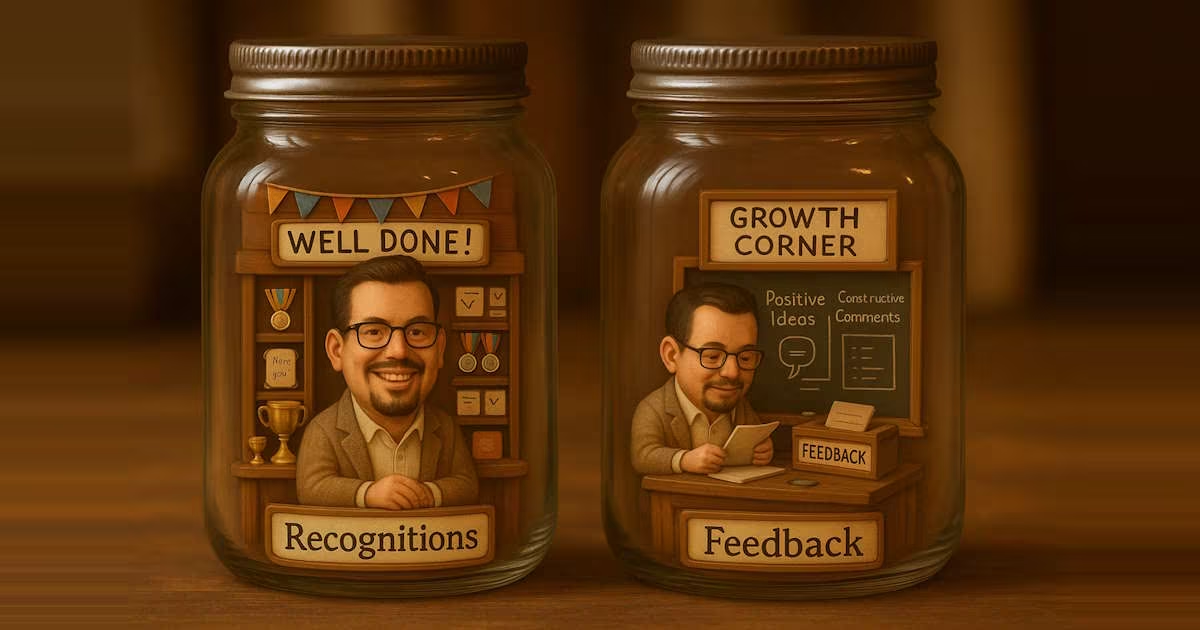
Recognition vs. Feedback: What's the Difference and Why It Matters
Two Powerful Tools, One Big Confusion
In the world of team communication, recognition and feedback are often used interchangeably. But they’re not the same—and confusing the two can seriously limit their impact.
One builds confidence. The other fuels growth.
One says, "I see you."
The other says, "Here’s how you can get better."
To create a high-performing, motivated and psychologically safe team, you need both—but you need to understand how they differ and when to use each.
What Is Recognition?
Recognition is about appreciation. It acknowledges effort, attitude, or results—often tied to values or behaviors you want to encourage.
💬 "Thanks for catching that issue before the release—great attention to detail!"
💬 "Really appreciated how you stepped up during the demo yesterday."
It’s:
- Positive
- Present-focused
- Motivational
It boosts morale, reinforces team culture and keeps energy high. Recognition is about who someone is or what they did well. If you want a simple, structured way to express meaningful appreciation, you can explore how kudo cards work.
What Is Feedback?
Feedback is about improvement. It helps someone grow by offering insight—whether affirming or constructive—on their behavior or outcomes.
💬 "Your presentation was strong—next time, try to simplify the technical slide for non-devs."
💬 "The way you handled that client pushback was great. One suggestion: pause more between responses."
It’s:
- Forward-looking
- Development-focused
- Can be positive or corrective
Feedback is about helping someone do even better next time.
Why the Confusion Matters
Many teams default to one and neglect the other. Here’s what happens:
❌ Recognition-only culture:
- Everyone feels good… until they stop growing.
- Teams avoid hard conversations in the name of "positivity".
- Underperformance might go unaddressed.
❌ Feedback-only culture:
- Teams improve—but motivation tanks.
- People feel like they’re always being "evaluated".
- Wins go unnoticed and burnout creeps in.
🔑 Healthy teams balance both.
Recognition reinforces what’s working. Feedback refines what’s next.
When to Use Recognition vs. Feedback
| Situation | Best Tool | Why |
|---|---|---|
| Someone helps unblock you | 🟢 Recognition | Reinforces collaboration & initiative |
| A teammate misses a detail in a story | 🟡 Feedback | Opportunity for learning & improvement |
| A sprint just wrapped up successfully | 🟢 Recognition | Celebrate shared achievement |
| A presentation lacked clarity | 🟡 Feedback | Constructive, helps them grow |
| Someone handled a conflict with empathy | 🟢 Recognition (and maybe feedback too!) | Reinforces the behavior & invites reflection |
How Recognition and Feedback Work Together
Recognition and feedback aren’t competing forces—they’re complementary tools.
Example:
You really owned the feature handoff—great leadership. One idea: next time, loop in QA earlier to tighten that testing window.
In one sentence, you’ve:
- ✅ Made the person feel seen
- ✅ Reinforced the behavior
- ✅ Offered a clear improvement path
To make this balance easier to practice daily, many teams use structured prompts like kudo cards to express recognition consistently, while saving feedback conversations for coaching and growth.
The Role of Tools Like esteam.life
Platforms like esteam.life help teams build recognition into the daily workflow—so appreciation doesn’t rely on memory or special ceremonies. This frees up your feedback moments to focus on learning and growth, while keeping energy and motivation high through continuous kudos.
The Takeaway
If you want your team to feel seen and grow—you need both recognition and feedback.
- Recognition says: "You matter and this was awesome."
- Feedback says: "You’ve got more potential and here’s how to level up."
One fuels confidence. The other sharpens skill.
✨ Use both—and your team will feel motivated, empowered and unstoppable.